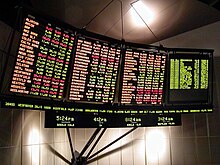Finance
| Part of a series on |
| Finance |
|---|
 |
|
Finance is the study and discipline of money, currency and capital assets.[a] It is related to and distinct from economics, which is the study of the production, distribution, and consumption of goods and services.[b] Based on the scope of financial activities in financial systems, the discipline can be divided into personal, corporate, and public finance.
In these financial systems, assets are bought, sold, or traded as financial instruments, such as currencies, loans, bonds, shares, stocks, options, futures, etc. Assets can also be banked, invested, and insured to maximize value and minimize loss. In practice, risks are always present in any financial action and entities.
Due to its wide scope, a broad range of subfields exists within finance.
. Financial analysis assesses the viability, stability, and profitability of an action or entity. Some fields are multidisciplinary, such asThe early history of finance parallels the early history of money, which is prehistoric. Ancient and medieval civilizations incorporated basic functions of finance, such as banking, trading and accounting, into their economies. In the late 19th century, the global financial system was formed.
In the middle of the 20th century, finance emerged as a distinct academic discipline,[c] separate from economics.[1] The earliest doctoral programs in finance were established in the 1960s and 1970s.[2] Today, finance is also widely studied through career-focused undergraduate and master's level programs.[3][4]
The financial system




As outlined, the financial system consists of the flows of capital that take place between individuals and households (personal finance), governments (public finance), and businesses (corporate finance). "Finance" thus studies the process of channeling money from savers and investors to entities that need it.[d] Savers and investors have money available which could earn interest or dividends if put to productive use. Individuals, companies and governments must obtain money from some external source, such as loans or credit, when they lack sufficient funds to run their operations.
In general, an entity whose income exceeds its expenditure can lend or invest the excess, intending to earn a fair return. Correspondingly, an entity where income is less than expenditure can raise capital usually in one of two ways:
(i) by borrowing in the form of a loan (private individuals), or by selling government or corporate bonds;
(ii) by a corporation selling equity, also called stock or shares (which may take various forms: preferred stock or common stock).
The owners of both bonds and stock may be
The
Investing typically entails the purchase of
Inter-institutional trade and investment, and fund-management at this scale, is referred to as "wholesale finance". Institutions here
Areas of finance
As outlined, finance comprises, broadly, the three areas of personal finance, corporate finance, and public finance. These, in turn, overlap and employ various activities and sub-disciplines—chiefly
Personal finance

Personal finance refers to the practice of budgeting to ensure enough funds on available to meet basic needs, while ensuring there is only a reasonable level of risk to lose said capital. Personal finance may involve paying for education, financing durable goods such as real estate and cars, buying insurance, investing, and saving for retirement.[9] Personal finance may also involve paying for a loan or other debt obligations. The main areas of personal finance are considered to be income, spending, saving, investing, and protection. The following steps, as outlined by the Financial Planning Standards Board,[10] suggest that an individual will understand a potentially secure personal finance plan after:
- Purchasing insurance to ensure protection against unforeseen personal events;
- Understanding the effects of tax policies, subsidies, or penalties on the management of personal finances;
- Understanding the effects of credit on individual financial standing;
- Developing a savings plan or financing for large purchases (auto, education, home);
- Planning a secure financial future in an environment of economic instability;
- Pursuing a checking or a savings account;
- Preparing for retirement or other long term expenses.[11]
Corporate finance
Corporate finance deals with the actions that managers take to increase the value of the firm to the shareholders, the sources of funding and the capital structure of corporations, and the tools and analysis used to allocate financial resources. While corporate finance is in principle different from managerial finance, which studies the financial management of all firms rather than corporations alone, the concepts are applicable to the financial problems of all firms,[12] and this area is then often referred to as "business finance".
Typically, "corporate finance" relates to the long term objective of maximizing the value of the entity's assets, its stock, and its return to shareholders, while also balancing risk and profitability. This entails[13] three primary areas:
- Capital budgeting: selecting which projects to invest in—here, accurately determining value is crucial, as judgements about asset values can be "make or break".[14]
- Dividend policy: the use of "excess" funds—these are to be reinvested in the business or returned to shareholders.
- Capital structure: deciding on the mix of funding to be used—here attempting to find the optimal capital mix re debt-commitments vs cost of capital.
The latter
Financial managers—i.e. as distinct from corporate financiers—focus more on the short term elements of profitability, cash flow, and "
Public finance


Public finance describes finance as related to sovereign states, sub-national entities, and related public entities or agencies. It generally encompasses a long-term strategic perspective regarding investment decisions that affect public entities.[15] These long-term strategic periods typically encompass five or more years.[16] Public finance is primarily concerned with:[17]
- Identification of required expendituresof a public sector entity;
- Source(s) of that entity's revenue;
- The budgeting process;
- Sovereign debt issuance, or municipal bonds for public works projects.
Central banks, such as the
Investment management



Investment management[12] is the professional asset management of various securities—typically shares and bonds, but also other assets, such as real estate, commodities and alternative investments—in order to meet specified investment goals for the benefit of investors.
As above, investors may be institutions, such as insurance companies, pension funds, corporations, charities, educational establishments, or private investors, either directly via investment contracts or, more commonly, via collective investment schemes like mutual funds,
At the heart of investment management[12] is asset allocation—diversifying the exposure among these asset classes, and among individual securities within each asset class—as appropriate to the client's investment policy, in turn, a function of risk profile, investment goals, and investment horizon (see Investor profile). Here:
- Portfolio optimization is the process of selecting the best portfolio given the client's objectives and constraints.
- Fundamental analysis is the approach typically applied in valuing and evaluating the individual securities.
- Technical analysis is about forecasting future asset prices with past data.[19]
Overlaid is the portfolio manager's
In a well-diversified portfolio, achieved
A quantitative fund is managed using computer-based mathematical techniques (increasingly, machine learning) instead of human judgment. The actual trading is typically automated via sophisticated algorithms.
Risk management


Risk management, in general, is the study of how to control risks and balance the possibility of gains; it is the process of measuring risk and then developing and implementing strategies to manage that risk. Financial risk management[20][21] is the practice of protecting corporate value against financial risks, often by "hedging" exposure to these using financial instruments. The focus is particularly on credit and market risk, and in banks, through regulatory capital, includes operational risk.
- Credit risk is the risk of default on a debt that may arise from a borrower failing to make required payments;
- Market risk relates to losses arising from movements in market variables such as prices and exchange rates;
- Operational risk relates to failures in internal processes, people, and systems, or to external events.
Financial risk management is related to corporate finance[12] in two ways. Firstly, firm exposure to market risk is a direct result of previous capital investments and funding decisions; while credit risk arises from the business's credit policy and is often addressed through credit insurance and provisioning. Secondly, both disciplines share the goal of enhancing or at least preserving, the firm's
Additional to diversification, the fundamental feature of risk mitigation here, investment managers will apply various hedging techniques to their portfolios as appropriate,[12] these may relate to the portfolio as a whole or to individual stocks. Bond portfolios are often (instead) managed via cash flow matching or immunization, while for derivative portfolios and positions, traders use "the Greeks" to measure and then offset sensitivities. In parallel, managers — active and passive — will monitor tracking error, thereby minimizing and preempting any underperformance vs their "benchmark".
Quantitative finance

Quantitative finance—also referred to as "mathematical finance"—includes those finance activities where a sophisticated mathematical model is required,[24] and thus overlaps several of the above.
As a specialized practice area, quantitative finance comprises primarily three sub-disciplines; the underlying theory and techniques are discussed in the next section:
- Quantitative finance is often synonymous with financial engineering. This area generally underpins a bank's customer-driven derivatives business—delivering bespoke OTC-contracts and "exotics", and designing the various structured products and solutions mentioned—and encompasses modeling and programming in support of the initial trade, and its subsequent hedging and management.
- Quantitative finance also significantly overlaps financial risk management in banking, as mentioned, both as regards this hedging, and as regards economic capital as well as compliance with regulations and the Basel capital / liquidity requirements.
- "Quants" are also responsible for building and deploying the investment strategies at the quantitative funds .
Financial theory
|
Financial theory is studied and developed within the disciplines of
Managerial finance

Managerial finance is the branch of management that concerns itself with the managerial application of finance techniques and theory, emphasizing the financial aspects of managerial decisions;[29] the assessment is per the managerial perspectives of planning, directing, and controlling. The techniques addressed and developed relate in the main to
Managerial finance, also known as corporate finance, is a branch of finance that deals with the financial decisions and management of a company. It involves the application of financial principles and techniques to optimize the value of a firm while managing its risks. The primary goal of managerial finance is to maximize shareholder wealth by making informed decisions related to capital budgeting, capital structure, and working capital management.
Key aspects of managerial finance include:
- Financial planning and forecasting: Managers analyze the company's financial position, set financial goals, and develop strategies to achieve those goals.
- Capital budgeting: This involves evaluating and selecting long-term investments, such as new projects, expansions, or acquisitions, based on their expected returns and risks.
- Capital structure: Managers determine the optimal mix of debt and equity financing to fund the company's operations and investments while minimizing the cost of capital.
- Working capital management: This focuses on managing short-term assets and liabilities, such as inventory, accounts receivable, and accounts payable, to ensure the company has sufficient liquidity to meet its operational needs.
- Risk management: Identifying, assessing, and managing various financial risks, such as interest rate risk, foreign exchange risk, and credit risk, to minimize their potential impact on the company's financial performance.
- Financial analysis and reporting: Managers analyze the company's financial statements, ratios, and performance metrics to assess its financial health, identify areas for improvement, and communicate with stakeholders.
Managerial finance professionals, such as financial managers, controllers, and treasurers, work closely with other departments within the organization to make strategic financial decisions that align with the company's overall objectives. They also interact with external stakeholders, such as investors, creditors, and financial institutions, to secure funding and manage financial relationships.
Financial economics

Financial economics
The discipline has two main areas of focus:[25] asset pricing and corporate finance; the first being the perspective of providers of capital, i.e. investors, and the second of users of capital; respectively:
- Asset pricing theory develops the models used in determining the risk-appropriate discount rate, and in pricing derivatives; and includes the investment theory applied in asset management. The analysis essentially explores how rational investors would apply risk and return to the problem of investment under uncertainty, producing the key "Fundamental theorem of asset pricing". Here, the twin assumptions of rationality and market efficiency lead to modern portfolio theory (the CAPM), and to the Black–Scholes theory for option valuation. At more advanced levels—and often in response to financial crises—the study then extends these "neoclassical" modelsto incorporate phenomena where their assumptions do not hold, or to more general settings.
- Much of real options analysis.
Financial mathematics
Financial mathematics[33] is the field of applied mathematics concerned with financial markets; Louis Bachelier's doctoral thesis, defended in 1900, is considered to be the first scholarly work in this area. The field is largely focused on the modeling of derivatives—with much emphasis on interest rate- and credit risk modeling—while other important areas include insurance mathematics and quantitative portfolio management. Relatedly, the techniques developed
-securities.As above, in terms of practice, the field is referred to as quantitative finance and / or mathematical finance, and comprises primarily the three areas discussed. The main mathematical tools and techniques are, correspondingly:
- for derivatives,Black-Scholes and the various numeric techniquesnow applied
- for risk management,"sensitivities" analysis (applying the "greeks"); the underlying mathematics comprises mixture models, PCA, volatility clustering and copulas.[35]
- in both of these areas, and particularly for portfolio problems, quants employ sophisticated optimization techniques
Mathematically, these separate into two analytic branches: derivatives pricing uses risk-neutral probability (or arbitrage-pricing probability), denoted by "Q"; while risk and portfolio management generally use physical (or actual or actuarial) probability, denoted by "P". These are interrelated through the above "Fundamental theorem of asset pricing".
The subject has a close relationship with financial economics, which, as outlined, is concerned with much of the underlying theory that is involved in financial mathematics: generally, financial mathematics will derive and extend the mathematical models suggested.
Experimental finance
Experimental finance[36] aims to establish different market settings and environments to experimentally observe and provide a lens through which science can analyze agents' behavior and the resulting characteristics of trading flows, information diffusion, and aggregation, price setting mechanisms, and returns processes. Researchers in experimental finance can study to what extent existing financial economics theory makes valid predictions and therefore prove them, as well as attempt to discover new principles on which such theory can be extended and be applied to future financial decisions. Research may proceed by conducting trading simulations or by establishing and studying the behavior of people in artificial, competitive, market-like settings.
Behavioral finance
Behavioral finance includes such topics as:
- Empirical studies that demonstrate significant deviations from classical theories;
- Models of how psychology affects and impacts trading and prices;
- Forecasting based on these methods;
- Studies of experimental asset markets and the use of models to forecast experiments.
A strand of behavioral finance has been dubbed quantitative behavioral finance, which uses mathematical and statistical methodology to understand behavioral biases in conjunction with valuation.
Environmental finance
Quantum finance
Quantum finance is an interdisciplinary research field, applying theories and methods developed by
History of finance
The origin of finance can be traced to the start of civilization. The earliest historical evidence of finance is dated to around 3000 BC. Banking originated in the Babylonian empire, where temples and palaces were used as safe places for the storage of valuables. Initially, the only valuable that could be deposited was grain, but cattle and precious materials were eventually included. During the same period, the Sumerian city of Uruk in Mesopotamia supported trade by lending as well as the use of interest. In Sumerian, "interest" was mas, which translates to "calf". In Greece and Egypt, the words used for interest, tokos and ms respectively, meant "to give birth". In these cultures, interest indicated a valuable increase, and seemed to consider it from the lender's point of view.[43] The Code of Hammurabi (1792–1750 BC) included laws governing banking operations. The Babylonians were accustomed to charging interest at the rate of 20 percent per annum.
Jews were not allowed to take interest from other Jews, but they were allowed to take interest from Gentiles, who had at that time no law forbidding them from practicing usury. As Gentiles took interest from Jews, the Torah considered it equitable that Jews should take interest from Gentiles. In Hebrew, interest is neshek.
By 1200 BC, cowrie shells were used as a form of money in China. By 640 BC, the Lydians had started to use coin money. Lydia was the first place where permanent retail shops opened. (Herodotus mentions the use of crude coins in Lydia in an earlier date, around 687 BC.)[44][45]
The use of coins as a means of representing money began in the years between 600 and 570 BCE. Cities under the
The first exchange happened in Belgium in 1531 AD.[47] Since, popular exchanges such as the London Stock Exchange (founded in 1773) and the New York Stock Exchange (founded in 1793) were created.[48][49]
See also
- Outline of finance
- Financial crisis of 2007–2010
Notes
- ^
The following are definitions of finance as crafted by the authors indicated:
- Fama and Miller: "The theory of finance is concerned with how individuals and firms allocate resources through time. In particular, it seeks to explain how solutions to the problems faced in allocating resources through time are facilitated by the existence of capital markets (which provide a means for individual economic agents to exchange resources to be available of different points In time) and of firms (which, by their production-investment decisions, provide a means for individuals to transform current resources physically into resources to be available in the future)."
- Guthmann and Dougall: "Finance is concerned with the raising and administering of funds and with the relationships between private profit-seeking enterprise on the one hand and the groups which supply the funds on the other. These groups, which include investors and speculators — that is, capitalists or property owners — as well as those who advance short-term capital, place their money in the field of commerce and industry and in return expect a stream of income."
- Drake and Fabozzi: "Finance is the application of economic principles to decision-making that involves the allocation of money under conditions of uncertainty."
- F.W. Paish: "Finance may be defined as the position of money at the time it is wanted".
- John J. Hampton: "The term finance can be defined as the management of the flows of money through an organisation, whether it will be a corporation, school, or bank or government agency".
- Howard and Upton: "Finance may be defined as that administrative area or set of administrative functions in an organisation which relates with the arrangement of each debt and credit so that the organisation may have the means to carry out the objectives as satisfactorily as possible".
- Pablo Fernandez: "Finance is a profession that requires interdisciplinary training and can help the managers of companies make sound decisions about financing, investment, continuity and other issues that affect the inflows and outflows of money, and the risk of the company. It also helps people and institutions invest and plan money-related issues wisely."
- ^ The discipline of financial economics bridges the two fields.
- ^ The first academic journal, The Journal of Finance, began publication in 1946.
- ^ Finance thus allows production and consumption in society to operate independently from each other. Without the use of financial allocation, production would have to happen at the same time and space as consumption. Through finance, distances in timespace between production and consumption are then posible.[5]
References
- ^ Hayes, Adam. "Finance". Investopedia. Archived from the original on 2020-12-19. Retrieved 2022-08-03.
- S2CID 154759424.
- ^ "Finance" Archived 2023-01-31 at the Wayback Machine, UCAS Subject Guide.
- ^ Anthony P. Carnevale, Ban Cheah, Andrew R. Hanson (2015). "The Economic Value of College Majors" Archived 2022-11-08 at the Wayback Machine. Georgetown University.
- from the original on 20 March 2022. Retrieved 3 June 2022.
- ^ See e.g., Bank of Finland. "Financial system". Archived from the original on 2020-06-02. Retrieved 2020-05-18.
- ^ "Introducing the Financial System | Boundless Economics". courses.lumenlearning.com. Archived from the original on 2020-07-28. Retrieved 2020-05-18.
- ^ "What is the financial system?". Economy. Archived from the original on 2020-07-31. Retrieved 2020-05-18.
- ISBN 978-1-68185-667-4.
- S2CID 242623141
- ^ Kenton, Will. "Personal Finance". Investopedia. Archived from the original on 2000-08-18. Retrieved 2020-01-20.
- ^
- ^ See Aswath Damodaran, Corporate Finance: First Principles Archived 2016-10-17 at the Wayback Machine
- ISBN 9781000024357. Archivedfrom the original on 11 November 2021. Retrieved 3 April 2021.
- ISBN 978-1439892237.
- ISBN 978-1439892237.
- ISBN 978-1-927472-59-0. Archivedfrom the original on 2022-06-15. Retrieved 2022-07-05.
- ^ Board of Governors of Federal Reserve System of the United States. Mission of the Federal Reserve System. Federalreserve.gov Accessed: 2010-01-16. (Archived by WebCite at Archived 2010-01-14 at the Wayback Machine)
- SSRN 3850494.
- ISBN 978-0-12-374448-7.
- ISBN 978-1-118-02291-7.
- ISBN 978-0814417447
- ^ a b See generally, Roy E. DeMeo (N.D.) Quantitative Risk Management: VaR and Others Archived 2021-11-12 at the Wayback Machine
- ^ See discussion here: "Careers in Applied Mathematics" (PDF). Society for Industrial and Applied Mathematics. Archived (PDF) from the original on 2019-03-05.
- ^ a b c See the discussion re finance theory by Fama and Miller under § Notes.
- ^ "Finance" Archived 2019-12-22 at the Wayback Machine Farlex Financial Dictionary. 2012
- ^ "Finance". Investopedia. May 23, 2023. Retrieved July 1, 2023.
- ^ A. Pinkasovitch (2021). Using Decision Trees in Finance Archived 2021-12-10 at the Wayback Machine
- ^ Managerial Finance, ScienceDirect
- ^ W. Kenton (2021). "Harry Markowitz" Archived 2021-11-26 at the Wayback Machine, investopedia.com
- ^ a b For an overview, see "Financial Economics" Archived 2004-06-04 at the Wayback Machine, William F. Sharpe (Stanford University manuscript)
- ^ "The History of the Black-Scholes Formula" Archived 2021-11-26 at the Wayback Machine, priceonomics.com
- ^ a b Research Area: Financial Mathematics and Engineering Archived 2022-05-16 at the Wayback Machine, Society for Industrial and Applied Mathematics
- ISBN 978-1118487716.
- ISBN 978-0976609704
- ISBN 978-0470499115
- ISBN 978-1-405-10746-4
- from the original on 2022-04-08. Retrieved 2022-04-08.
- ISBN 978-0195304213. Retrieved 8 May 2017.
growth of behavioral finance.
- ISBN 978-3-662-48174-5.
- ^ ISBN 978-0-470-94973-3.[page needed]
- .
- ^ Fergusson, Nial. The Ascent of Money. United States: Penguin Books.
- ^ "Herodotus on Lydia". World History Encyclopedia. Archived from the original on 2021-05-13. Retrieved 2021-05-13.
- ^ "babylon-coins.com". babylon-coins.com. Archived from the original on 2021-06-15. Retrieved 2021-05-13.
- ^ "History of Usury Prohibition - IslamiCity". www.islamicity.org. Archived from the original on 2023-04-09. Retrieved 2023-04-09.
- ^ "Handelsbeurs" [Trade fair]. Visit Antwerp (in Dutch). Retrieved 2 September 2022.
The 'Nieuwe Beurs' was built in 1531 because the 'Old Beurs' in Hofstraat had become too small. It was the first stock exchange ever built specifically for that purpose and later became the example for all stock exchange buildings in the world.
- ^ "Our History". London Stock Exchange. Archived from the original on 2 September 2022. Retrieved 2 September 2022.
- ^ "Research Guides: Wall Street and the Stock Exchanges: Historical Resources: Stock Exchanges". Library of Congress. Archived from the original on 4 August 2022. Retrieved 2 September 2022.
Further reading
- ISBN 0-06-055566-1.
- Graham, Benjamin; LCCN 34023635.
- ISBN 0-446-67745-0
- ISBN 9780470102107.
- ISBN 978-0-470-82441-2.
- LCCN 98046515.
- LCCN 87004745.
- LCCN 95051449.
External links
- Finance Definition (Investopedia)
- Hypertextual Finance Glossary (Campbell Harvey)
- Finance Glossary (Vernimmen et. al.)
- Corporate finance resources (Aswath Damodaran)
- Financial management resources (James Van Horne)
- Personal finance resources (Financial Literacy and Education Commission, mymoney.gov)
- Public finance resources Archived 2023-06-02 at the Wayback Machine (Governance and Social Development Resource Centre, gsdrc.org)
- Risk management resources (Global Risk Institute)

![{\displaystyle \sum _{t=1}^{n}{\frac {FCFF_{t}}{(1+WACC_{t})^{t}}}+{\frac {\left[{\frac {FCFF_{n+1}}{(WACC_{n+1}-g_{n+1})}}\right]}{(1+WACC_{n})^{n}}}}](https://wikimedia.org/api/rest_v1/media/math/render/svg/a22b05672cab39b95519d0347e9a4892559f1531)
![{\displaystyle {\begin{aligned}C(S,t)&=N(d_{1})S-N(d_{2})Ke^{-r(T-t)}\\d_{1}&={\frac {1}{\sigma {\sqrt {T-t}}}}\left[\ln \left({\frac {S}{K}}\right)+\left(r+{\frac {\sigma ^{2}}{2}}\right)(T-t)\right]\\d_{2}&=d_{1}-\sigma {\sqrt {T-t}}\\\end{aligned}}}](https://wikimedia.org/api/rest_v1/media/math/render/svg/f6ed0aef39b1aee3a602de0faf6224848c506363)